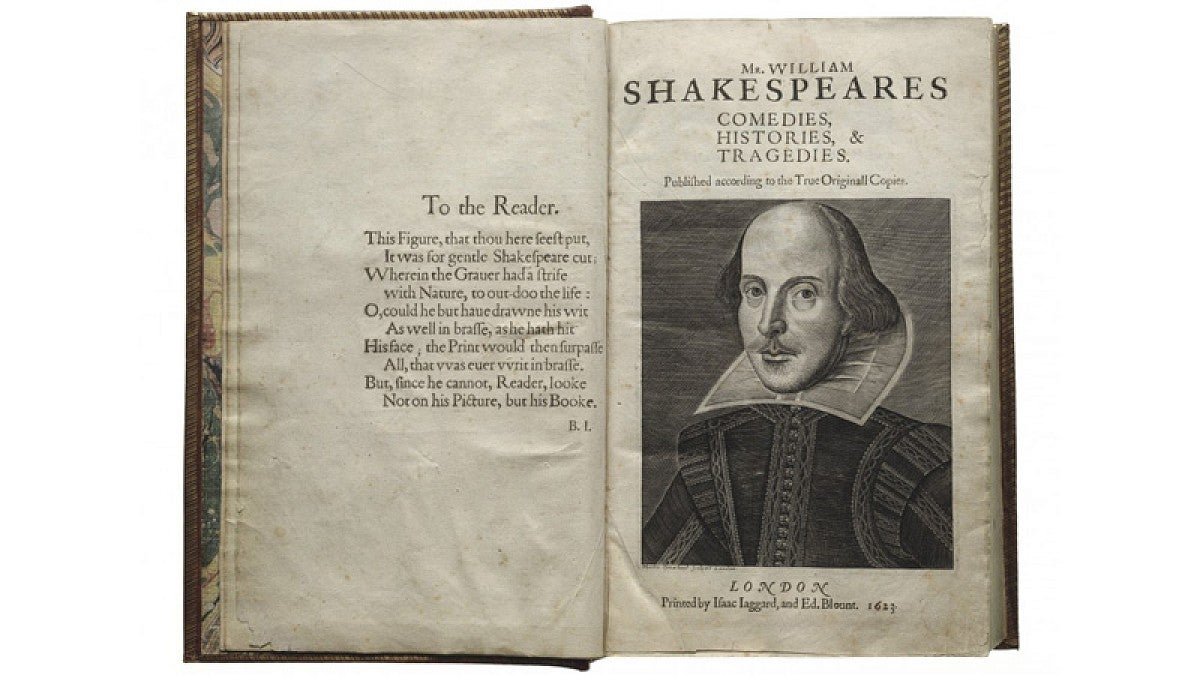Shakespeare's death is being remembered — and the playwright’s works celebrated — in Eugene, thanks to Lara Bovilsky, associate professor of English. She submitted the successful application for the UO to host "First Folio! The Book that Gave Us Shakespeare” at the Jordan Schnitzer Museum of Art, Jan. 6 to Feb. 7.
RELATED LINKS
Bovilsky also is curator a companion exhibition that will be on display at the Knight Library.
Below, Bovilsky provides answers to five important questions:
Are UO students interested in Shakespeare?
Yes, our students love Shakespeare! When you teach a beginners’ class on Shakespeare you are meeting students from all across the university, not just English majors but business majors and others. What students are taught in high school often focuses on understanding the plot and the basic meaning of the words, so they don’t always have time to think about the language or learn about the culture. They really enjoy learning about how different Shakespeare’s world was from our own, in positive and negative ways.
Only two of Shakespeare’s plays have main plots that he wrote himself. He stole the plots of all the rest of them from other people and adapted them, so just following his stories is not really focusing on what he was thinking about.
Can you put in a nutshell the kinds of themes that Shakespeare was most interested in?
His culture was interested in violent revenge tragedy, and the plays he wrote that were the most popular in his own time were disturbingly violent — "Hamlet, Titus Andronicus, Richard III." He picked up on that appetite. But he’s also interested in the difficulties of being in a family, especially a political family, and how hard it is to have relationships in a family when people are not just involved with each other as family members but must treat each other as political agents. In all of his work, he was thinking about the kinds of ways that stories were told in that culture, and telling them in new ways.
What is on display at the Knight Library?
We have a companion exhibition, "Time’s Pencil: Shakespeare After the Folio," that I have curated with incredible support from Bruce Tabb in Special Collections. It shows what happened to the idea of Shakespeare in the centuries after the First Folio was published. It wasn’t until the late 17th and 18th centuries that he became revered as a genius.
At that point, Shakespeare’s plays were performed all the time, but in radically changed versions that appealed to the sensibilities of these later time periods. They thought they loved Shakespeare, but what they really loved was "King Lear" with a happy ending, or "Richard III" with some major characters removed. We have examples of those altered plays in the exhibition. Also starting in the 18th century, editors started trying to recover Shakespeare’s “true” texts. They published a string of editions attempting to produce the authentic versions — and of course, all of them are different, as are all modern editions. We have some of these on display.
And then we have fan fiction written by 19th century authors — both about Shakespeare and about his characters, and a case that shows the history of Shakespeare appreciation and performance in Eugene from 1893 until now.
So, was Eugene big on Shakespeare?
While Shakespeare became wildly popular in Britain in the late 18th and 19th centuries, he was actually even more popular in the United States. You could live in a small town in the U.S. and there would be traveling troupes that would come perform. Europeans who visited the U.S. in the 18th and 19th centuries describe going into rural cottages and finding the works of Shakespeare next to the Bible. So it’s not at all surprising that we find that there were two Shakespeare societies in Eugene, and we have the original minutes of their meetings and some correspondence on display.
We also have a cool set of images from 80 years of productions of "A Midsummer Night’s Dream" that were put on at the University of Oregon. It includes a production on a floating stage in the Mill Pond and one in Mac Court.
What gave you the idea that you could make a successful pitch to bring First Folio to the UO?
In thinking about what would make us stand out from other Oregon applicants, we immediately thought of Oregon Shakespeare Festival, which is an incredible resource, and the JSMA. Having a museum of the caliber of the Jordan Schnitzer certainly helped our bid. The educational programs they do are just phenomenal. And in addition, the Knight Library’s Special Collections owns an original first folio of Ben Jonson’s "Workes," which we thought would enrich the Folger’s exhibition and which will be on display at the JSMA.
That book is significant because it was the first to claim that plays were important literature and gave Shakespeare’s friends the idea to publish his works after his death. So all of those things were appealing to the Folger and we were picked.
See the story "A Treasure Bound: Shakespeare’s First Folio at the JSMA" or see information on the exhibit's page on the JSMA's website to learn more about the exhibits at the JSMA and Knight Library.


